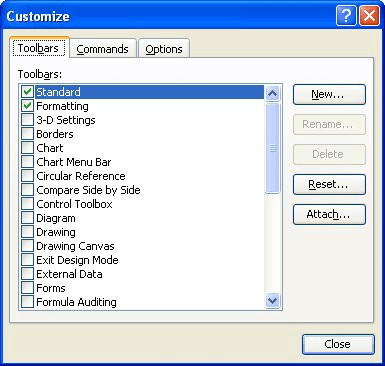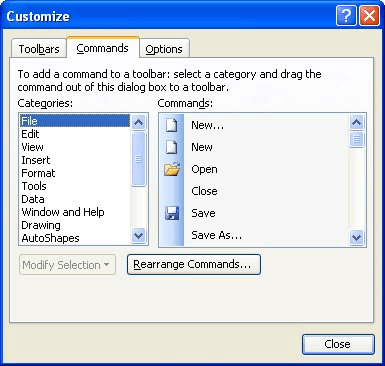Written by Allen Wyatt (last updated October 2, 2021)
This tip applies to Excel 97, 2000, 2002, and 2003
Excel is a very flexible program. You can configure it to work just about any way you can imagine. For instance, you can create a macro, and then add it to a toolbar. To do this, follow these steps:

Figure 1. The Toolbars tab of the Customize dialog box.

Figure 2. The Commands tab of the Customize dialog box.
Note:
ExcelTips is your source for cost-effective Microsoft Excel training. This tip (2926) applies to Microsoft Excel 97, 2000, 2002, and 2003.

Best-Selling VBA Tutorial for Beginners Take your Excel knowledge to the next level. With a little background in VBA programming, you can go well beyond basic spreadsheets and functions. Use macros to reduce errors, save time, and integrate with other Microsoft applications. Fully updated for the latest version of Office 365. Check out Microsoft 365 Excel VBA Programming For Dummies today!
Macros are great at working with text. This tip presents an example that shows this versatility by reversing the contents ...
Discover MoreExcel allows you to hide worksheets so that they aren't visible to those using your workbook. Hiding worksheets has a ...
Discover MoreWant to use a worksheet function (such as SUM) from within a macro? Here's how easy it is to accomplish the task.
Discover MoreFREE SERVICE: Get tips like this every week in ExcelTips, a free productivity newsletter. Enter your address and click "Subscribe."
There are currently no comments for this tip. (Be the first to leave your comment—just use the simple form above!)
Got a version of Excel that uses the menu interface (Excel 97, Excel 2000, Excel 2002, or Excel 2003)? This site is for you! If you use a later version of Excel, visit our ExcelTips site focusing on the ribbon interface.
FREE SERVICE: Get tips like this every week in ExcelTips, a free productivity newsletter. Enter your address and click "Subscribe."
Copyright © 2025 Sharon Parq Associates, Inc.
Comments